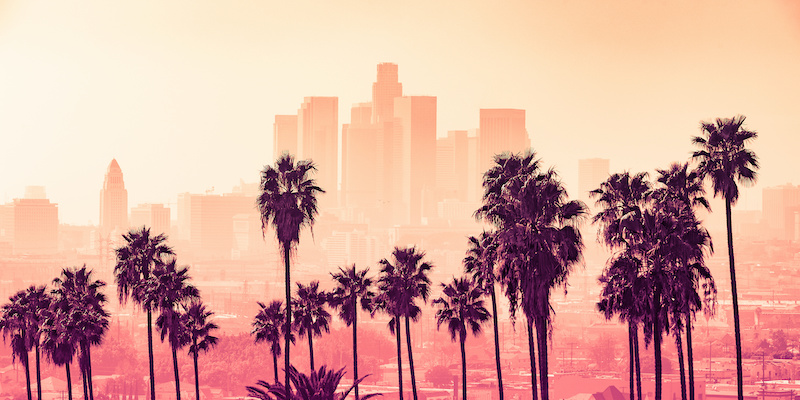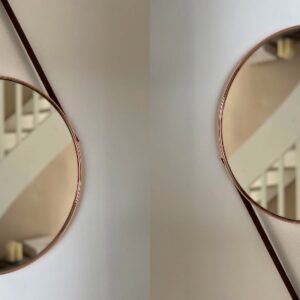Los Angeles is the quintessential city of mystery, and I firmly believe that my decision to live here ultimately led me to write crime fiction. But that journey took decades.
I wasn’t one of the starry-eyed optimists who thought of LA as the promised land. When I moved from New York City to Los Angeles 30 years ago, I did so with trepidation. Actually, that’s putting a good face on my true feelings. Though I was originally a transplant from the Midwest to the Big Apple, I’d become one of those New Yorkers with a decidedly jaundiced view of the West Coast. And as a costume designer who made her living in theater, my attitude toward the movie business was equally disdainful. At the time, I thought that making the jump from stage to film was tantamount to “selling out.”
But the practical side of my nature told me it would be wise to take a closer look at the more lucrative business of film, and if I was going to do that, I wanted to do it where they invented the industry.
In hindsight, I admit that a big part of my prejudice regarding the move stemmed from my fear of the unknown. Plus, I was still quite young, idealistic, and in many ways, naive. Despite my doubts, I moved to Los Angeles in October of 1990, rented a tiny apartment in Silverlake, and bought a used car. And I was lucky enough to land a job in movies within 2 weeks of landing in LA, which sealed the deal for me. I became a reluctant Angeleno and for the next 27 years, I made my living in the film industry.
During those years, my relationship with my adopted city went through many phases. I was still living in that little apartment in Silverlake when riots blew up the city that still felt new to me in 1992. I’d been working over on the Sony Studios lot that day, and when the violence erupted, the studio closed early in the afternoon. As I made the 15-mile trip across town via Venice Boulevard, I drove past burning strip malls and cars full of young men who brandished baseball bats at unlucky motorists like me who were just hoping to get home.
And I’m very grateful that I did make it safely to my apartment where I holed up for the next 3 days, feeling frightened and heartbroken for the entire city. That’s a piece LA’s history I’ll carry with me for the rest of my life, and though I hope we’ll never see that kind of violence again, the problems that sparked the riots have never been fully rooted out.
I’ve come to understand that Los Angeles will always have a dark side. It’s inevitable in a city so vast, so populous, and so complex — a sociological stew that makes LA unique. I cherish that diversity, even though I recognize that simmering conflict is a residual element of our blended society. For this diehard LA convert, the benefits of mixing all those rich cultural influences far outweigh any negative issues created by their synergy.
Over time, that realization has gradually transformed my relationship with my adopted city. Los Angeles has been such an important part of my life experience and my development as both a human being and an artist that the city and I now belong together in a way I could never have imagined when I moved here. I’ve had the great good fortune to make wonderful life-long friends and enjoyed a long, lucrative career working on the costumes for movies like Forrest Gump, Apollo 13, The Curious Case of Benjamin Button, and X-Men Days of Future Past.
And when I felt it was time to make yet another major life transition, changing my vocation from working in film to writing mystery fiction, I knew the kaleidoscopic nature of Los Angeles would be my touchstone because my heart will always be at home here.
But LA is not only the location for my books; I think of the city as a living, breathing character in my stories. They couldn’t be written about anyplace else in the world. In part that’s because the books are set behind the scenes in the movie business.
The film industry and the city of Los Angeles were born together; it’s arguable each made the other’s existence viable — not twins but rather symbiotic partners that supported and cross-pollinated one another until both grew into the giant entities they’ve become. Now you don’t think of one without the other; they’re inseparable in the popular zeitgeist, their combined magic luring dreamers from all over the world.
And though it’s certainly possible to be inspired by the sheer scope and magnificence of Los Angeles as a symbol of glamour and excitement — many artists, writers, and filmmakers have ingeniously used those qualities to great effect in their work — I prefer more intimate glimpses into the many hearts and faces that make up this beautiful, troubling, complicated city.
Because that immense sprawl, the unending carpet of lights that’s often used as visual shorthand for LA is just a superficial image. It has nothing to do with the true identity of the city, which is actually a patchwork of many different communities. Some are incorporated as separate municipalities, yet they march shoulder to shoulder from the foothills of the San Gabriel Valley to the Pacific Ocean with boundaries that exist only on paper. East LA, El Sereno, Downtown Los Angeles (which also encompasses Little Tokyo and Chinatown), Echo Park, Silverlake, Koreatown, Hollywood, West Hollywood, Beverly Hills, Culver City, Venice, and Santa Monica, each community with a distinct personality, some of which have blended over time, settling into various stages of overlapping influences with one another.
That’s part of the real magic of Los Angeles — the schizy, unpredictable interplay between those different faces of the city is a continuous source of drama, the heart of any good story and definitely any good mystery. Anyway, that’s how it seems to me. I’m humbled to realize after all these years that my adopted city and my adopted profession are two of the greatest sources of inspiration for my writing.
I’ve always been an avid reader. From childhood I dreamed of being a writer, and I’ve written for my own creative satisfaction throughout my life. But it wasn’t until I’d been in LA and working on movies for a number of years that I became a real fan of mystery fiction. And that happened almost by accident. I discovered that one of the few ways I could disengage my brain from the workday of a busy film was to read a good murder mystery at bedtime. Eventually (after reading several hundred in that genre) I started to imagine writing murder mystery stories of my own.
So it was the combination of the years I’ve spent living in LA and learning to appreciate all the nuances of the city together with the variety of (sometimes jaw-dropping) experiences I’ve had working on movies that finally led me to write crime fiction.
Turns out, a big movie in production is the perfect setting for a murder mystery because a movie company is its own unique community — a microcosm of the larger society that spawned it — but with its own set of relationships and always plenty of drama happening behind the scenes.
Final Cut, the first book in my Hollywood Mystery series featuring movie key costumer Joey Jessop as the main character, was inspired by situations I encountered on one film in particular that I won’t name here. I didn’t stumble over the body of a fellow crew member on the set as Joey did, but many of the other incidents that appear in the book parallel actual events.
Star Struck, Hollywood Mystery Book #2 was based in part on my experiences within the film world, but the incident that triggers the mystery, a fatal traffic accident near the movie set where Joey and her colleagues are working, was inspired by a startling event I witnessed in downtown Los Angeles. I watched in horror as a wild-eyed girl dashed barefoot through traffic across one of the wide north-south avenues. Fortunately, that girl made it to the opposite side of the street without being injured. But I’ll never forget her death-defying sprint or the panic I felt until she leaped safely onto the sidewalk without breaking stride. No one appeared to be chasing her, and I’ve always wondered what made her run. It’s a mystery that’s stayed with me, a seed of an idea that grew into a story.
For me, that kind of capriciousness is a treasure that makes Los Angeles a Pandora’s box of imagination, a source of both great misfortune and hope — an endless well of creative inspiration for nearly any story about any sort of person who might be living or traveling through this iconic crossroads of the world.
***


















